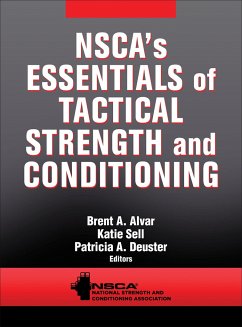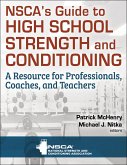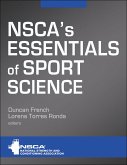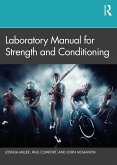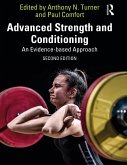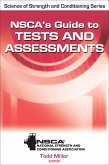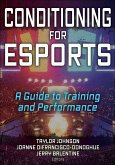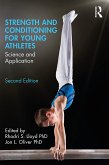NSCA -National Strength & Conditioning Association
NSCA's Essentials of Tactical Strength and Conditioning
NSCA -National Strength & Conditioning Association
NSCA's Essentials of Tactical Strength and Conditioning
- Gebundenes Buch
- Merkliste
- Auf die Merkliste
- Bewerten Bewerten
- Teilen
- Produkt teilen
- Produkterinnerung
- Produkterinnerung
A reference guide for health and wellness professionals who work with tactical populations such as military, law enforcement and fire/rescue personnel.
Andere Kunden interessierten sich auch für
![NSCA's Guide to High School Strength and Conditioning NSCA's Guide to High School Strength and Conditioning]() NSCA's Guide to High School Strength and Conditioning60,99 €
NSCA's Guide to High School Strength and Conditioning60,99 €![NSCA's Essentials of Sport Science NSCA's Essentials of Sport Science]() NSCA's Essentials of Sport Science100,99 €
NSCA's Essentials of Sport Science100,99 €![Laboratory Manual for Strength and Conditioning Laboratory Manual for Strength and Conditioning]() Joshua MillerLaboratory Manual for Strength and Conditioning68,99 €
Joshua MillerLaboratory Manual for Strength and Conditioning68,99 €![Advanced Strength and Conditioning Advanced Strength and Conditioning]() Advanced Strength and Conditioning60,99 €
Advanced Strength and Conditioning60,99 €![NSCA's Guide to Tests and Assessments NSCA's Guide to Tests and Assessments]() NSCA's Guide to Tests and Assessments69,99 €
NSCA's Guide to Tests and Assessments69,99 €![Conditioning for Esports Conditioning for Esports]() Conditioning for Esports43,99 €
Conditioning for Esports43,99 €![Strength and Conditioning for Young Athletes Strength and Conditioning for Young Athletes]() Strength and Conditioning for Young Athletes49,99 €
Strength and Conditioning for Young Athletes49,99 €-
-
-
A reference guide for health and wellness professionals who work with tactical populations such as military, law enforcement and fire/rescue personnel.
Hinweis: Dieser Artikel kann nur an eine deutsche Lieferadresse ausgeliefert werden.
Hinweis: Dieser Artikel kann nur an eine deutsche Lieferadresse ausgeliefert werden.
Produktdetails
- Produktdetails
- Verlag: Human Kinetics Publishers
- Seitenzahl: 688
- Erscheinungstermin: 24. Februar 2017
- Englisch
- Abmessung: 297mm x 222mm x 38mm
- Gewicht: 2138g
- ISBN-13: 9781450457309
- ISBN-10: 1450457304
- Artikelnr.: 45671883
- Herstellerkennzeichnung
- Libri GmbH
- Europaallee 1
- 36244 Bad Hersfeld
- gpsr@libri.de
- Verlag: Human Kinetics Publishers
- Seitenzahl: 688
- Erscheinungstermin: 24. Februar 2017
- Englisch
- Abmessung: 297mm x 222mm x 38mm
- Gewicht: 2138g
- ISBN-13: 9781450457309
- ISBN-10: 1450457304
- Artikelnr.: 45671883
- Herstellerkennzeichnung
- Libri GmbH
- Europaallee 1
- 36244 Bad Hersfeld
- gpsr@libri.de
About the NSCA The National Strength and Conditioning Association (NSCA) is the world's leading organization in the field of sport conditioning. Drawing on the resources and expertise of the most recognized professionals in strength training and conditioning, sport science, performance research, education, and sports medicine, the NSCA is the world's trusted source of knowledge and training guidelines for coaches, athletes, and tactical operators. The NSCA provides the crucial link between the lab and the field. About the Editors Brent A. Alvar, PhD, CSCS,*D, RSCC*D, FNSCA, is a professor of health science at Rocky Mountain University of Health Professions. He is a certified strength and conditioning specialist with distinction, registered strength and conditioning coach with distinction, and a fellow of the NSCA. Alvar was named the NSCA's Educator of the Year in 2016 and is a past member of the NSCA Board of Directors. At Rocky Mountain University, Alvar served as the director, the associate dean and vice president of university research, the concentration track director for the doctoral program in Human & Sport Performance, and the codirector of the graduate program in health promotion and wellness. Alvar also served as the sport performance director and faculty member at Chandler Gilbert Community College while simultaneously having an appointment as an assistant research professor in the department of exercise and wellness at Arizona State University, where he earned his bachelor's, master's, and doctoral degrees. Alvar's primary research focus is in the area of physical activity related to human performance and occupational preparedness as well as the muscular strength and health-related benefits from resistance training. Katie Sell, PhD, CSCS,*D, TSAC-F, ACSM EP-C, is an associate professor and coordinator of the undergraduate exercise science program in the department of health professions at Hofstra University. Her NSCA certifications include being a certified strength and conditioning specialist with distinction and a tactical strength and conditioning facilitator. She is also an exercise physiologist certified with the American College of Sports Medicine (ACSM). Sell has been a volunteer assistant coach for the Hofstra women's tennis program, a member of the NSCA Tactical Strength and Conditioning Special Interest Group Executive Council, and a consultant to FireFit, which is an interagency wildland firefighter fitness task group. She serves as a physical fitness standards and programming consultant with various professional firefighting departments in the Salt Lake City, Utah, region. Sell's primary research interests are in the areas of physical activity promotion among college students and firefighter health, physical fitness, and exercise programming. She received her doctoral degree from the University of Utah, her master's degree from Southern Illinois University, and her bachelor's degree from the University of Tennessee at Martin. Patricia A. Deuster, PhD, MPH, CNS, is a professor in the department of military and emergency medicine at the Uniformed Services University of the Health Sciences (USU) and director of the Consortium for Health and Military Performance (CHAMP), the Defense Center of Excellence in the area of human performance optimization. A certified nutrition specialist and fellow of the American College of Sports Medicine (ACSM), Deuster is a coauthor of The Navy SEAL Nutrition Guide and The Special Operations Forces Nutrition Guide and the editor of The Navy SEAL Physical Fitness Guide. Deuster received the Special Operations Medical Researcher Award in 2014 by the Special Operations Medical Association. She is a member of the Order of Military Medical Merit and has served the Department of Defense on its Dietary Supplement Subcommittee, Food and Nutrition Subcommittee, Human Performance Optimization Committee, Population Health Working Group, and Operational Supplement Safety Initiative. Deuster received her bachelor's and master's degrees from the College of William and Mary, her PhD from the University of Maryland, and her MPH from USU. Among her athletic achievements, she has been a tennis professional, nationally ranked marathoner, and qualifier for the first women's marathon Olympic Trials in 1984.
Chapter 1: Tactical Strength and Conditioning: An Overview Brent A. Alvar, PhD, CSCS,*D, RSCC*D, FNSCA Katie Sell, PhD, CSCS,*D, TSAC-F Patricia A. Deuster, PhD, MPH, CNS NSCA TSAC Program Duties of a Tactical Athlete Job Analysis of a Tactical Athlete Assessment of the Individual Program Design Chapter 2: Cardiopulmonary and Endocrine Responses and Adaptations to Exercise Denise Smith, PhD Cardiovascular Structure and Function Pulmonary Anatomy and Function Acute Cardiovascular Responses to Exercise Acute Respiratory Responses to Exercise Acute Endocrine Responses to Exercise Chronic Adaptations of the Cardiopulmonary and Endocrine Systems to Exercise and High-Stress Situations Chapter 3: Skeletal Muscle Anatomy and Biomechanics Michael R. Deschenes, PhD Raymond W. McCoy, PhD Bones and the Skeleton Skeletal Muscle Muscle Mechanics Neuromuscular Anatomy Neural Responses During Exercise Biomechanical Principles Types of Muscle-Strengthening Exercises Biomechanical Factors Affecting Muscle Strength Chapter 4: Physiological Adaptations and Bioenergetics Todd Miller, PhD, CSCS,*D, TSAC
F, FNSCA Bioenergetics and Metabolism Physiological Adaptations to Exercise Detraining and Retraining Chapter 5: Basic Nutrition for Tactical Populations Steve Hertzler, PhD, RD, LD Amanda Carlson-Phillips, MS, RD, CSSD Guidelines for Dispensing Nutrition Information Step 1: Understand the Demands of the Tactical Athlete Step 2: Understand Basic Fueling Concepts Step 3: Provide Nutritional Guidance Step 4: Create Nutritional Recommendations to Support Performance and Recovery Providing Guidance on Energy Balance and Nutrition Tools Chapter 6: Tactical Fueling Maj. Nicholas D. Barringer, PhD, RD, CSCS,*D, CSSD Maj. Aaron P. Crombie, PhD, RD Nutritional Needs of Tactical Athletes Nutrient Requirements of Tactical Athletes Under Various Conditions Nutrition-Related Conditions and Chronic Diseases of Tactical Athletes Chapter 7: Ergogenic Aids Abbie E. Smith-Ryan, PhD, CSCS,*D, FNSCA Colin D. Wilborn, PhD, CSCS, ATC Eric T. Trexler, MA, CSCS Regulation of Dietary Supplements Anti-Doping Agencies and Dietary Supplement Resources Risk Stratification of Supplements Common Performance-Enhancing Substances: Potential Benefits, Risks, and Side Effects Illegal Performance-Enhancing Substances Signs and Symptoms of Ergogenic Aid Abuse Chapter 8: Testing and Evaluation of Tactical Populations Bradley J. Warr, PhD, MPAS Patrick Gagnon, MS Dennis E. Scofield, MEd, CSCS Suzanne Jaenen, MS History of Fitness Testing in Tactical Occupations Types of Performance Tests Testing Procedures Evaluation of Performance Test Results Use of Performance Test Results Chapter 9: Development of Resistance Training Programs Nicholas A. Ratamess, PhD, CSCS,*D, FNSCA Needs Analysis Resistance Training Program Design Chapter 10: Periodization for Tactical Populations G. Gregory Haff, PhD, CSCS,*D, FNSCA, ASCC Defining Periodization Goals of Periodization Principles of Periodization Models Structural Components of Periodized Training Sequencing and Integrating Training Applying Periodization Theory to Deployment-Based Tactical Athletes Applying Periodization Theory to Nondeployed Tactical Athletes Chapter 11: Resistance Training Exercise Techniques Jason Dudley, MS, CSCS,*D, TSAC
F, RSCC, FMS
1, USAW
1 Brad Schoenfeld, PhD, CSCS, NSCA
CPT, FNSCA Performing Exercises With Alternative Implements Warm-Up Before Resistance Training Guidelines on Body Stance and Alignment, Breathing, and Spotting Resistance Training Exercises Chapter 12: Flexibility and Mobility Exercise Techniques and Programming Mark Stephenson, MS, ATC, CSCS,*D, TSAC-F Daniel J. Dodd, PhD, CSCS Comparison of Mobility and FlexibilityTypes of Flexibility and Mobility Exercises Exercise Technique and Cueing Guidelines Program Design Chapter 13: Plyometric, Speed, and Agility Exercise Techniques and Programming Mike Barnes, MEd, CSCS, NSCA
CPT Jay Dawes, PhD, CSCS,*D, NSCA
CPT,*D, FNSCA Plyometric Training Speed Training Agility Training Chapter 14: Aerobic Endurance Exercise Techniques and Programming Matthew R. Rhea, PhD, CSCS,*D Brent A. Alvar, PhD, CSCS,*D, RSCC*D, FNSCA Warming Up Before Aerobic Endurance Training Exercise Techniques and Cueing Guidelines Step 1: Exercise Mode Step 2: Training Frequency Step 3: Training Intensity Step 4: Exercise Duration Step 5: Exercise Progression Program Design Recommendations Chapter 15: Evidence-Based Approach to Strength and Power Training to Improve Performance in Tactical Populations Dennis E. Scofield, MEd, CSCS Sarah E. Sauers, MS, CSCS Barry A. Spiering, PhD, CSCS Marilyn A. Sharp, MS Bradley C. Nindl, PhD Overview of Occupational Demands Optimizing Occupational Performance Applying Principles of Strength and Power Training Chapter 16: Care and Rehabilitation of Injured Tactical Populations Danny McMillian, PT, DSc Common Injury Prevalence and Risk Factors Phases of Tissue Healing Causes, Signs, and Symptoms of Overtraining Syndrome Maintenance of Training Status During Rehabilitation and Reconditioning Guidelines for Injury Care and Rehabilitation Chapter 17: Physiological Issues Related to Fire and Rescue Personnel Katie Sell, PhD, CSCS,*D, TSAC-F,*D Mark Abel, PhD, CSCS,*D, TSAC-F,*D, USAW Joseph Domitrovich, PhD Critical Job Tasks for Firefighters Environmental, Occupational, and Exposure Concerns Injury and Illness Risks in Firefighters Optimizing Functional Fitness Program Design and Sample Training Approaches Chapter 18: Physiological Issues Related to Law Enforcement Personnel Ben Hinton, MSc, CSCS Sgt Mick Sterli, BPhysEd, MExSc, CSCS,*D, TSAC
F,*D Robin Orr, PhD, MPhty, BFET, TSAC-F Critical Job Tasks for Law Enforcement Personnel Environmental, Occupational, and Exposure Concerns Injury and Illness Risks Optimizing Functional Fitness Key Program Variables Chapter 19: Physiological Issues Related to Military Personnel William Kraemer, PhD, CSCS,*D, FNSCA LTC David Feltwell, PT, OCS, TSAC-F Tunde Szivak, PhD, CSCS Critical Job Tasks for Conventional Military and Special Operations Personnel Environmental, Occupational, and Exposure Concerns Injury and Illness Risks Optimizing Functional Fitness Program Design and Sample Training Approaches Chapter 20: Physical Training to Optimize Load Carriage Paul C. Henning, PhD, CSCS Barry A. Spiering, PhD, CSCS Dennis E. Scofield, MEd, CSCS Bradley C. Nindl, PhD Impact of Equipment Load on Biomechanical Demands Physiological and Biomechanical Demands of Load Carriage Practical Considerations for Training Programs to Optimize Load Carriage Chapter 21: Wellness Interventions in Tactical Populations Robin Orr, PhD, MPhty, BFET, TSAC-F John R. Bennett, MS, CSCS, EMT-P Chronic Illness and Diseases Conditions Common in Tactical Populations Risk Factors Requiring Wellness Interventions Operating Wellness Programs for Tactical Populations Chapter 22: Organization and Administration Considerations John Hofman, Jr, MS, CSCS, USAW, USA T&F, FMS Frank A. Palkoska, MS, CSCS Design Layout and Organization Policies and Procedures Safe Training Environment
F, FNSCA Bioenergetics and Metabolism Physiological Adaptations to Exercise Detraining and Retraining Chapter 5: Basic Nutrition for Tactical Populations Steve Hertzler, PhD, RD, LD Amanda Carlson-Phillips, MS, RD, CSSD Guidelines for Dispensing Nutrition Information Step 1: Understand the Demands of the Tactical Athlete Step 2: Understand Basic Fueling Concepts Step 3: Provide Nutritional Guidance Step 4: Create Nutritional Recommendations to Support Performance and Recovery Providing Guidance on Energy Balance and Nutrition Tools Chapter 6: Tactical Fueling Maj. Nicholas D. Barringer, PhD, RD, CSCS,*D, CSSD Maj. Aaron P. Crombie, PhD, RD Nutritional Needs of Tactical Athletes Nutrient Requirements of Tactical Athletes Under Various Conditions Nutrition-Related Conditions and Chronic Diseases of Tactical Athletes Chapter 7: Ergogenic Aids Abbie E. Smith-Ryan, PhD, CSCS,*D, FNSCA Colin D. Wilborn, PhD, CSCS, ATC Eric T. Trexler, MA, CSCS Regulation of Dietary Supplements Anti-Doping Agencies and Dietary Supplement Resources Risk Stratification of Supplements Common Performance-Enhancing Substances: Potential Benefits, Risks, and Side Effects Illegal Performance-Enhancing Substances Signs and Symptoms of Ergogenic Aid Abuse Chapter 8: Testing and Evaluation of Tactical Populations Bradley J. Warr, PhD, MPAS Patrick Gagnon, MS Dennis E. Scofield, MEd, CSCS Suzanne Jaenen, MS History of Fitness Testing in Tactical Occupations Types of Performance Tests Testing Procedures Evaluation of Performance Test Results Use of Performance Test Results Chapter 9: Development of Resistance Training Programs Nicholas A. Ratamess, PhD, CSCS,*D, FNSCA Needs Analysis Resistance Training Program Design Chapter 10: Periodization for Tactical Populations G. Gregory Haff, PhD, CSCS,*D, FNSCA, ASCC Defining Periodization Goals of Periodization Principles of Periodization Models Structural Components of Periodized Training Sequencing and Integrating Training Applying Periodization Theory to Deployment-Based Tactical Athletes Applying Periodization Theory to Nondeployed Tactical Athletes Chapter 11: Resistance Training Exercise Techniques Jason Dudley, MS, CSCS,*D, TSAC
F, RSCC, FMS
1, USAW
1 Brad Schoenfeld, PhD, CSCS, NSCA
CPT, FNSCA Performing Exercises With Alternative Implements Warm-Up Before Resistance Training Guidelines on Body Stance and Alignment, Breathing, and Spotting Resistance Training Exercises Chapter 12: Flexibility and Mobility Exercise Techniques and Programming Mark Stephenson, MS, ATC, CSCS,*D, TSAC-F Daniel J. Dodd, PhD, CSCS Comparison of Mobility and FlexibilityTypes of Flexibility and Mobility Exercises Exercise Technique and Cueing Guidelines Program Design Chapter 13: Plyometric, Speed, and Agility Exercise Techniques and Programming Mike Barnes, MEd, CSCS, NSCA
CPT Jay Dawes, PhD, CSCS,*D, NSCA
CPT,*D, FNSCA Plyometric Training Speed Training Agility Training Chapter 14: Aerobic Endurance Exercise Techniques and Programming Matthew R. Rhea, PhD, CSCS,*D Brent A. Alvar, PhD, CSCS,*D, RSCC*D, FNSCA Warming Up Before Aerobic Endurance Training Exercise Techniques and Cueing Guidelines Step 1: Exercise Mode Step 2: Training Frequency Step 3: Training Intensity Step 4: Exercise Duration Step 5: Exercise Progression Program Design Recommendations Chapter 15: Evidence-Based Approach to Strength and Power Training to Improve Performance in Tactical Populations Dennis E. Scofield, MEd, CSCS Sarah E. Sauers, MS, CSCS Barry A. Spiering, PhD, CSCS Marilyn A. Sharp, MS Bradley C. Nindl, PhD Overview of Occupational Demands Optimizing Occupational Performance Applying Principles of Strength and Power Training Chapter 16: Care and Rehabilitation of Injured Tactical Populations Danny McMillian, PT, DSc Common Injury Prevalence and Risk Factors Phases of Tissue Healing Causes, Signs, and Symptoms of Overtraining Syndrome Maintenance of Training Status During Rehabilitation and Reconditioning Guidelines for Injury Care and Rehabilitation Chapter 17: Physiological Issues Related to Fire and Rescue Personnel Katie Sell, PhD, CSCS,*D, TSAC-F,*D Mark Abel, PhD, CSCS,*D, TSAC-F,*D, USAW Joseph Domitrovich, PhD Critical Job Tasks for Firefighters Environmental, Occupational, and Exposure Concerns Injury and Illness Risks in Firefighters Optimizing Functional Fitness Program Design and Sample Training Approaches Chapter 18: Physiological Issues Related to Law Enforcement Personnel Ben Hinton, MSc, CSCS Sgt Mick Sterli, BPhysEd, MExSc, CSCS,*D, TSAC
F,*D Robin Orr, PhD, MPhty, BFET, TSAC-F Critical Job Tasks for Law Enforcement Personnel Environmental, Occupational, and Exposure Concerns Injury and Illness Risks Optimizing Functional Fitness Key Program Variables Chapter 19: Physiological Issues Related to Military Personnel William Kraemer, PhD, CSCS,*D, FNSCA LTC David Feltwell, PT, OCS, TSAC-F Tunde Szivak, PhD, CSCS Critical Job Tasks for Conventional Military and Special Operations Personnel Environmental, Occupational, and Exposure Concerns Injury and Illness Risks Optimizing Functional Fitness Program Design and Sample Training Approaches Chapter 20: Physical Training to Optimize Load Carriage Paul C. Henning, PhD, CSCS Barry A. Spiering, PhD, CSCS Dennis E. Scofield, MEd, CSCS Bradley C. Nindl, PhD Impact of Equipment Load on Biomechanical Demands Physiological and Biomechanical Demands of Load Carriage Practical Considerations for Training Programs to Optimize Load Carriage Chapter 21: Wellness Interventions in Tactical Populations Robin Orr, PhD, MPhty, BFET, TSAC-F John R. Bennett, MS, CSCS, EMT-P Chronic Illness and Diseases Conditions Common in Tactical Populations Risk Factors Requiring Wellness Interventions Operating Wellness Programs for Tactical Populations Chapter 22: Organization and Administration Considerations John Hofman, Jr, MS, CSCS, USAW, USA T&F, FMS Frank A. Palkoska, MS, CSCS Design Layout and Organization Policies and Procedures Safe Training Environment
Chapter 1: Tactical Strength and Conditioning: An Overview Brent A. Alvar, PhD, CSCS,*D, RSCC*D, FNSCA Katie Sell, PhD, CSCS,*D, TSAC-F Patricia A. Deuster, PhD, MPH, CNS NSCA TSAC Program Duties of a Tactical Athlete Job Analysis of a Tactical Athlete Assessment of the Individual Program Design Chapter 2: Cardiopulmonary and Endocrine Responses and Adaptations to Exercise Denise Smith, PhD Cardiovascular Structure and Function Pulmonary Anatomy and Function Acute Cardiovascular Responses to Exercise Acute Respiratory Responses to Exercise Acute Endocrine Responses to Exercise Chronic Adaptations of the Cardiopulmonary and Endocrine Systems to Exercise and High-Stress Situations Chapter 3: Skeletal Muscle Anatomy and Biomechanics Michael R. Deschenes, PhD Raymond W. McCoy, PhD Bones and the Skeleton Skeletal Muscle Muscle Mechanics Neuromuscular Anatomy Neural Responses During Exercise Biomechanical Principles Types of Muscle-Strengthening Exercises Biomechanical Factors Affecting Muscle Strength Chapter 4: Physiological Adaptations and Bioenergetics Todd Miller, PhD, CSCS,*D, TSAC
F, FNSCA Bioenergetics and Metabolism Physiological Adaptations to Exercise Detraining and Retraining Chapter 5: Basic Nutrition for Tactical Populations Steve Hertzler, PhD, RD, LD Amanda Carlson-Phillips, MS, RD, CSSD Guidelines for Dispensing Nutrition Information Step 1: Understand the Demands of the Tactical Athlete Step 2: Understand Basic Fueling Concepts Step 3: Provide Nutritional Guidance Step 4: Create Nutritional Recommendations to Support Performance and Recovery Providing Guidance on Energy Balance and Nutrition Tools Chapter 6: Tactical Fueling Maj. Nicholas D. Barringer, PhD, RD, CSCS,*D, CSSD Maj. Aaron P. Crombie, PhD, RD Nutritional Needs of Tactical Athletes Nutrient Requirements of Tactical Athletes Under Various Conditions Nutrition-Related Conditions and Chronic Diseases of Tactical Athletes Chapter 7: Ergogenic Aids Abbie E. Smith-Ryan, PhD, CSCS,*D, FNSCA Colin D. Wilborn, PhD, CSCS, ATC Eric T. Trexler, MA, CSCS Regulation of Dietary Supplements Anti-Doping Agencies and Dietary Supplement Resources Risk Stratification of Supplements Common Performance-Enhancing Substances: Potential Benefits, Risks, and Side Effects Illegal Performance-Enhancing Substances Signs and Symptoms of Ergogenic Aid Abuse Chapter 8: Testing and Evaluation of Tactical Populations Bradley J. Warr, PhD, MPAS Patrick Gagnon, MS Dennis E. Scofield, MEd, CSCS Suzanne Jaenen, MS History of Fitness Testing in Tactical Occupations Types of Performance Tests Testing Procedures Evaluation of Performance Test Results Use of Performance Test Results Chapter 9: Development of Resistance Training Programs Nicholas A. Ratamess, PhD, CSCS,*D, FNSCA Needs Analysis Resistance Training Program Design Chapter 10: Periodization for Tactical Populations G. Gregory Haff, PhD, CSCS,*D, FNSCA, ASCC Defining Periodization Goals of Periodization Principles of Periodization Models Structural Components of Periodized Training Sequencing and Integrating Training Applying Periodization Theory to Deployment-Based Tactical Athletes Applying Periodization Theory to Nondeployed Tactical Athletes Chapter 11: Resistance Training Exercise Techniques Jason Dudley, MS, CSCS,*D, TSAC
F, RSCC, FMS
1, USAW
1 Brad Schoenfeld, PhD, CSCS, NSCA
CPT, FNSCA Performing Exercises With Alternative Implements Warm-Up Before Resistance Training Guidelines on Body Stance and Alignment, Breathing, and Spotting Resistance Training Exercises Chapter 12: Flexibility and Mobility Exercise Techniques and Programming Mark Stephenson, MS, ATC, CSCS,*D, TSAC-F Daniel J. Dodd, PhD, CSCS Comparison of Mobility and FlexibilityTypes of Flexibility and Mobility Exercises Exercise Technique and Cueing Guidelines Program Design Chapter 13: Plyometric, Speed, and Agility Exercise Techniques and Programming Mike Barnes, MEd, CSCS, NSCA
CPT Jay Dawes, PhD, CSCS,*D, NSCA
CPT,*D, FNSCA Plyometric Training Speed Training Agility Training Chapter 14: Aerobic Endurance Exercise Techniques and Programming Matthew R. Rhea, PhD, CSCS,*D Brent A. Alvar, PhD, CSCS,*D, RSCC*D, FNSCA Warming Up Before Aerobic Endurance Training Exercise Techniques and Cueing Guidelines Step 1: Exercise Mode Step 2: Training Frequency Step 3: Training Intensity Step 4: Exercise Duration Step 5: Exercise Progression Program Design Recommendations Chapter 15: Evidence-Based Approach to Strength and Power Training to Improve Performance in Tactical Populations Dennis E. Scofield, MEd, CSCS Sarah E. Sauers, MS, CSCS Barry A. Spiering, PhD, CSCS Marilyn A. Sharp, MS Bradley C. Nindl, PhD Overview of Occupational Demands Optimizing Occupational Performance Applying Principles of Strength and Power Training Chapter 16: Care and Rehabilitation of Injured Tactical Populations Danny McMillian, PT, DSc Common Injury Prevalence and Risk Factors Phases of Tissue Healing Causes, Signs, and Symptoms of Overtraining Syndrome Maintenance of Training Status During Rehabilitation and Reconditioning Guidelines for Injury Care and Rehabilitation Chapter 17: Physiological Issues Related to Fire and Rescue Personnel Katie Sell, PhD, CSCS,*D, TSAC-F,*D Mark Abel, PhD, CSCS,*D, TSAC-F,*D, USAW Joseph Domitrovich, PhD Critical Job Tasks for Firefighters Environmental, Occupational, and Exposure Concerns Injury and Illness Risks in Firefighters Optimizing Functional Fitness Program Design and Sample Training Approaches Chapter 18: Physiological Issues Related to Law Enforcement Personnel Ben Hinton, MSc, CSCS Sgt Mick Sterli, BPhysEd, MExSc, CSCS,*D, TSAC
F,*D Robin Orr, PhD, MPhty, BFET, TSAC-F Critical Job Tasks for Law Enforcement Personnel Environmental, Occupational, and Exposure Concerns Injury and Illness Risks Optimizing Functional Fitness Key Program Variables Chapter 19: Physiological Issues Related to Military Personnel William Kraemer, PhD, CSCS,*D, FNSCA LTC David Feltwell, PT, OCS, TSAC-F Tunde Szivak, PhD, CSCS Critical Job Tasks for Conventional Military and Special Operations Personnel Environmental, Occupational, and Exposure Concerns Injury and Illness Risks Optimizing Functional Fitness Program Design and Sample Training Approaches Chapter 20: Physical Training to Optimize Load Carriage Paul C. Henning, PhD, CSCS Barry A. Spiering, PhD, CSCS Dennis E. Scofield, MEd, CSCS Bradley C. Nindl, PhD Impact of Equipment Load on Biomechanical Demands Physiological and Biomechanical Demands of Load Carriage Practical Considerations for Training Programs to Optimize Load Carriage Chapter 21: Wellness Interventions in Tactical Populations Robin Orr, PhD, MPhty, BFET, TSAC-F John R. Bennett, MS, CSCS, EMT-P Chronic Illness and Diseases Conditions Common in Tactical Populations Risk Factors Requiring Wellness Interventions Operating Wellness Programs for Tactical Populations Chapter 22: Organization and Administration Considerations John Hofman, Jr, MS, CSCS, USAW, USA T&F, FMS Frank A. Palkoska, MS, CSCS Design Layout and Organization Policies and Procedures Safe Training Environment
F, FNSCA Bioenergetics and Metabolism Physiological Adaptations to Exercise Detraining and Retraining Chapter 5: Basic Nutrition for Tactical Populations Steve Hertzler, PhD, RD, LD Amanda Carlson-Phillips, MS, RD, CSSD Guidelines for Dispensing Nutrition Information Step 1: Understand the Demands of the Tactical Athlete Step 2: Understand Basic Fueling Concepts Step 3: Provide Nutritional Guidance Step 4: Create Nutritional Recommendations to Support Performance and Recovery Providing Guidance on Energy Balance and Nutrition Tools Chapter 6: Tactical Fueling Maj. Nicholas D. Barringer, PhD, RD, CSCS,*D, CSSD Maj. Aaron P. Crombie, PhD, RD Nutritional Needs of Tactical Athletes Nutrient Requirements of Tactical Athletes Under Various Conditions Nutrition-Related Conditions and Chronic Diseases of Tactical Athletes Chapter 7: Ergogenic Aids Abbie E. Smith-Ryan, PhD, CSCS,*D, FNSCA Colin D. Wilborn, PhD, CSCS, ATC Eric T. Trexler, MA, CSCS Regulation of Dietary Supplements Anti-Doping Agencies and Dietary Supplement Resources Risk Stratification of Supplements Common Performance-Enhancing Substances: Potential Benefits, Risks, and Side Effects Illegal Performance-Enhancing Substances Signs and Symptoms of Ergogenic Aid Abuse Chapter 8: Testing and Evaluation of Tactical Populations Bradley J. Warr, PhD, MPAS Patrick Gagnon, MS Dennis E. Scofield, MEd, CSCS Suzanne Jaenen, MS History of Fitness Testing in Tactical Occupations Types of Performance Tests Testing Procedures Evaluation of Performance Test Results Use of Performance Test Results Chapter 9: Development of Resistance Training Programs Nicholas A. Ratamess, PhD, CSCS,*D, FNSCA Needs Analysis Resistance Training Program Design Chapter 10: Periodization for Tactical Populations G. Gregory Haff, PhD, CSCS,*D, FNSCA, ASCC Defining Periodization Goals of Periodization Principles of Periodization Models Structural Components of Periodized Training Sequencing and Integrating Training Applying Periodization Theory to Deployment-Based Tactical Athletes Applying Periodization Theory to Nondeployed Tactical Athletes Chapter 11: Resistance Training Exercise Techniques Jason Dudley, MS, CSCS,*D, TSAC
F, RSCC, FMS
1, USAW
1 Brad Schoenfeld, PhD, CSCS, NSCA
CPT, FNSCA Performing Exercises With Alternative Implements Warm-Up Before Resistance Training Guidelines on Body Stance and Alignment, Breathing, and Spotting Resistance Training Exercises Chapter 12: Flexibility and Mobility Exercise Techniques and Programming Mark Stephenson, MS, ATC, CSCS,*D, TSAC-F Daniel J. Dodd, PhD, CSCS Comparison of Mobility and FlexibilityTypes of Flexibility and Mobility Exercises Exercise Technique and Cueing Guidelines Program Design Chapter 13: Plyometric, Speed, and Agility Exercise Techniques and Programming Mike Barnes, MEd, CSCS, NSCA
CPT Jay Dawes, PhD, CSCS,*D, NSCA
CPT,*D, FNSCA Plyometric Training Speed Training Agility Training Chapter 14: Aerobic Endurance Exercise Techniques and Programming Matthew R. Rhea, PhD, CSCS,*D Brent A. Alvar, PhD, CSCS,*D, RSCC*D, FNSCA Warming Up Before Aerobic Endurance Training Exercise Techniques and Cueing Guidelines Step 1: Exercise Mode Step 2: Training Frequency Step 3: Training Intensity Step 4: Exercise Duration Step 5: Exercise Progression Program Design Recommendations Chapter 15: Evidence-Based Approach to Strength and Power Training to Improve Performance in Tactical Populations Dennis E. Scofield, MEd, CSCS Sarah E. Sauers, MS, CSCS Barry A. Spiering, PhD, CSCS Marilyn A. Sharp, MS Bradley C. Nindl, PhD Overview of Occupational Demands Optimizing Occupational Performance Applying Principles of Strength and Power Training Chapter 16: Care and Rehabilitation of Injured Tactical Populations Danny McMillian, PT, DSc Common Injury Prevalence and Risk Factors Phases of Tissue Healing Causes, Signs, and Symptoms of Overtraining Syndrome Maintenance of Training Status During Rehabilitation and Reconditioning Guidelines for Injury Care and Rehabilitation Chapter 17: Physiological Issues Related to Fire and Rescue Personnel Katie Sell, PhD, CSCS,*D, TSAC-F,*D Mark Abel, PhD, CSCS,*D, TSAC-F,*D, USAW Joseph Domitrovich, PhD Critical Job Tasks for Firefighters Environmental, Occupational, and Exposure Concerns Injury and Illness Risks in Firefighters Optimizing Functional Fitness Program Design and Sample Training Approaches Chapter 18: Physiological Issues Related to Law Enforcement Personnel Ben Hinton, MSc, CSCS Sgt Mick Sterli, BPhysEd, MExSc, CSCS,*D, TSAC
F,*D Robin Orr, PhD, MPhty, BFET, TSAC-F Critical Job Tasks for Law Enforcement Personnel Environmental, Occupational, and Exposure Concerns Injury and Illness Risks Optimizing Functional Fitness Key Program Variables Chapter 19: Physiological Issues Related to Military Personnel William Kraemer, PhD, CSCS,*D, FNSCA LTC David Feltwell, PT, OCS, TSAC-F Tunde Szivak, PhD, CSCS Critical Job Tasks for Conventional Military and Special Operations Personnel Environmental, Occupational, and Exposure Concerns Injury and Illness Risks Optimizing Functional Fitness Program Design and Sample Training Approaches Chapter 20: Physical Training to Optimize Load Carriage Paul C. Henning, PhD, CSCS Barry A. Spiering, PhD, CSCS Dennis E. Scofield, MEd, CSCS Bradley C. Nindl, PhD Impact of Equipment Load on Biomechanical Demands Physiological and Biomechanical Demands of Load Carriage Practical Considerations for Training Programs to Optimize Load Carriage Chapter 21: Wellness Interventions in Tactical Populations Robin Orr, PhD, MPhty, BFET, TSAC-F John R. Bennett, MS, CSCS, EMT-P Chronic Illness and Diseases Conditions Common in Tactical Populations Risk Factors Requiring Wellness Interventions Operating Wellness Programs for Tactical Populations Chapter 22: Organization and Administration Considerations John Hofman, Jr, MS, CSCS, USAW, USA T&F, FMS Frank A. Palkoska, MS, CSCS Design Layout and Organization Policies and Procedures Safe Training Environment

